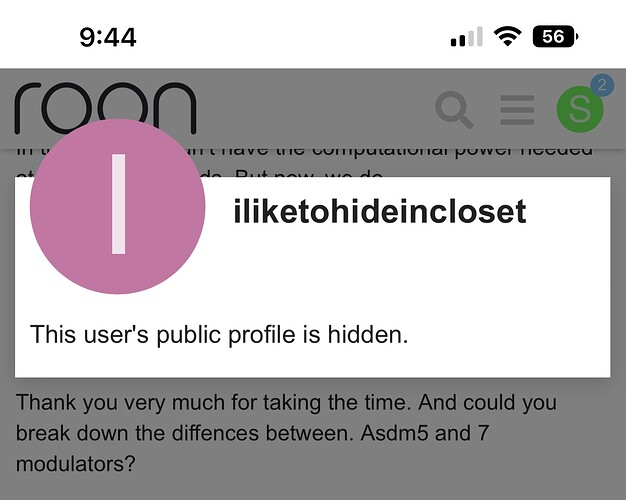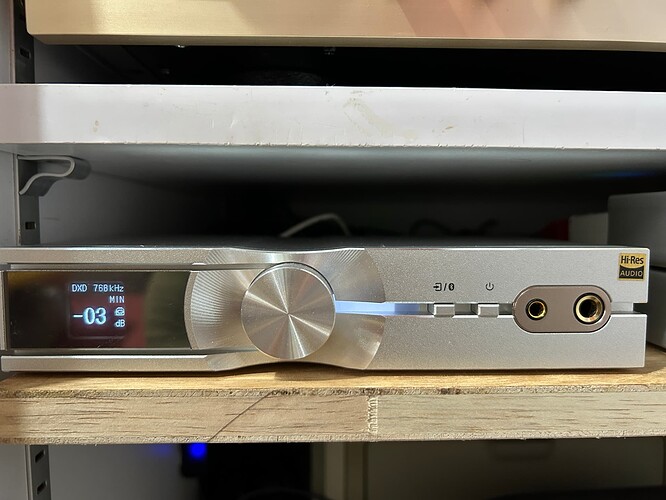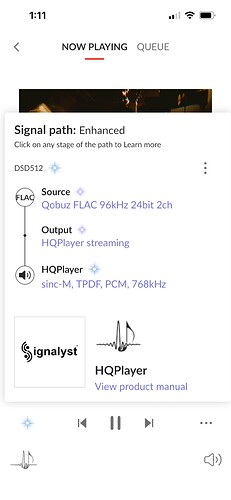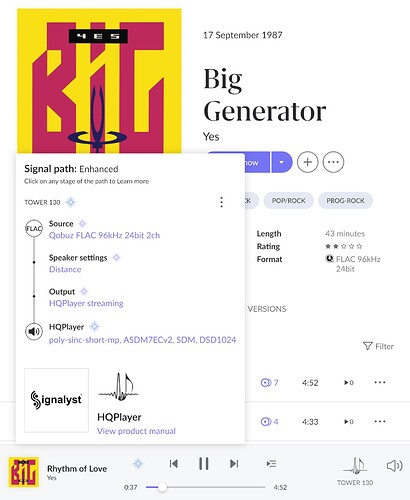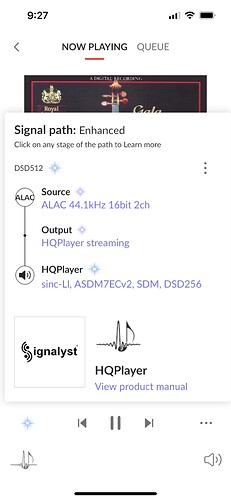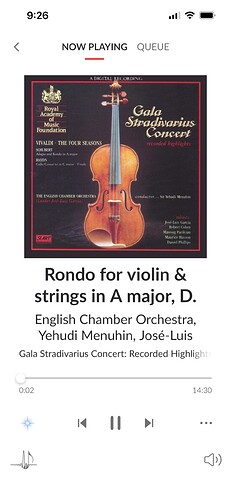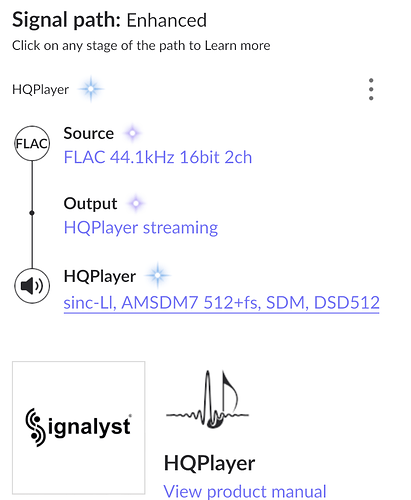I am really enjoying closed-form-fast ASDM7ECv2 DSD128 - pushing my laptop cpu to its OC limits .
But this combination is so dynamic to my ears
M1 Pro Mac and Musician Pegasus DAC
I spent a lot of time with the gauss filters and ECV2 modulators but I’ve found that for studio recordings DSD512, AMSDM7EC 512+ES and poly-sync-mp-2s yields the fullest, most dynamic, and most satisfying combination.
Could someone please recommend a good DSD Source Setting as I just bought some DSD albums online. This is for playing DSD source by upsampling to DSD or keeping it intact. Also: (1) should I be checking on +6db? (2) should I check on Native DSD?
Currently, this is my setup:
Roon (on Intel NUC) —> ethernet —> network —> ethernet —> HQP Desktop (on M1 Max Mac Studio) —> ethernet —> network —> ethernet —> SMS-200Ultra Neo —> USB —> Holo May DAC —> Holo Serene —> Hegel H30 —> Focal Maestro Utopia + 2 REL subs
I currently upsample either to 768KHz (LNS15, Sinc-L) or to DSD256 (ASDM7ECV2, poly-sinc-gauss-long, poly-sinc-gauss-hires-lp) or DSD512 (ASDM7, same 2 filters).
I normally set the Holo Serene to about 8dB volume level higher than I need and then control the volume using HQPlayer volume.
6 dB gain affects only DSD to PCM conversion, so it doesn’t apply here. Do not set Direct SDM as the HQPlayer volume control will be lost.
I recommend latest default settings; Integrator FIR2 and Conversion XFi. Modulator ASDM7ECv2.
Upsample to DSD512 if you have the power to do it with ASDM7ECv2. Otherwise stick to to DSD256.
If you use both sides of the Holo DAC, remember to set PCM Gain Compensation to -6 dB.
Sorry if you have already posted this, but could you please elaborate on the role of the modulator? When we talk abou filters, to me is clearer: we are discussing attenuation and how close to Nyquist, with the trade offs of phase and pre ringing or post ringing (please correct me if I am wrong).
But when we talk about modulator, I cannot put my finger on what’s the discussion is really about. Once you shape the noise to be above Nyquist, and you have a high attenuation filter engaged, why should it matter?
The way I explain it to people in simple language - the modulator is the part of HQPlayer that converts the upsampled ~80-bit (or whatever it is) @ final high sample rate to the final 1-bit (same final high sample rate) SDM format.
A reasonable simple explanation @jussi_laako ?
Thanks for your reply. This is quite new to me. My understanding is that, in practical senses, the modulator affected the noise shaping, that is, at what frequency the noise floor begin to rise, keeping a low quantization noise profile throughout the audible band
My description above (which could be wrong) is just high level.
There’s a lot that goes into that conversion to the final 1-bit - which includes what you wrote and other stuff.
I have exactly the same experience. Sinc LM just gives the sweetest tone. I have tried most of the filters extensively but keep coming back to sinc LM. I also find checking 48K and setting DSD512 at 48k just seems to work best with my equipment. I think some of this is dac dependant. I am using and Ares II
Yes, that’s correct.
That is also correct.
Dither/noise-shaping is part of limiting output word length in a way that you don’t get distortions and you maximize audio band signal to noise ratio.
Noise-shaping is fundamental part of SDM.
PCM (Pulse Code Modulation) or SDM (Sigma-Delta Modulation). In both cases you have mathematical modulation of values according to input stimulus. Usually former is mathematically simpler process compared to latter, at the cost of word length.
PCM trades mathematical complexity with converter hardware complexity. When you are constrained in terms of mathematical computation capability, PCM is an option that puts complexity demand on the analog conversion hardware. But since analog physical world is limited by realities of physical world you quickly find a lot of challenges because you are asking for component manufacturing tolerances in range of 0.00000059605%. While commercial reality even for expensive gear is closer to 0.01%. This also comes with similar settling-time requirements, since sampling rate requires that the converter settles to ½LSB accurate DC level within small portion of sample period time. In addition, you will need analog filter that has no phase shift or attenuation by 20 kHz, but will have 144 dB attenuation by Nyquist of the converter sampling rate. Which demands for higher sampling rate which in turn puts more demand on the settling time.
SDM solves this by moving complexity and accuracy to mathematical / computational domain. You do a lot of computations to produce (statistically) good values, but both the conversion hardware and the analog filter become much simpler. And the converter accuracy and analog filter attenuation demands are much lower. And settling requirement to ½LSB gets much more relaxed when you have just few levels.
In the end, for any converter implementation, there are one or two a sweet spots in sampling rate where the converter hardware performs in an optimal way. The aspects to look at are
- Lowest audio band SNR
- Lowest wide band SNR
- Best reconstruction accuracy
Where last item depends on digital filters, conversion rate and the analog filter involved in conversion.
Both PCM (R2R) and SDM converter cases can be helped with suitable DSP. Just like headphones, loudspeakers, etc. In the 80’s, we didn’t have the computational power needed at everybody’s hands. But now, we do.
Thank you very much for taking the time. And could you break down the diffences between. Asdm5 and 7 modulators?
poly-sinc-gauss-long for me. makes the timing feel just right.
“Sinc-xx” are very impressive at times, aren’t they?
If your HW permits try Sinc-Ll @ DSD256 (or even on @128) with classical music, especially strings, take Vivaldi for starters, oh my…
When source and filter match is made in heaven
I’ve been using Nx: poly-sinc-short-mp for progressive content a lot lately. You just cant stop listening…
As for the sound production and attention to details I would add another two: Fripp and Sylvian. I think for Sylvian every work is a masterpiece, like a well made painting with million of details, I’ve rediscovered all again with HQP. Caught my wife “shazaming” my play lists, hehehe ![]()
You and your 1024DSD… lol ![]()
![]()
![]()
![]()
sincLI is great solo classical… but for whatever reason I keep going back to sincLm.
I can only get to 512DSD but I’m still on a 9th gen i9 chip.
I have T+A DAC8 and I used xtr-lp for long time with DSD512.
Recently I got a new GPU (3090) and I can do sinc-LI which sounds amazing.
I can do sinc-LI + EC7v2 in DSD256 but I prefer sinc-LI without EC (can’t do it with my CPU) in DSD512. I think DSD512 is still the sweet spot for this DAC even if I can do use EC with DSD256.
